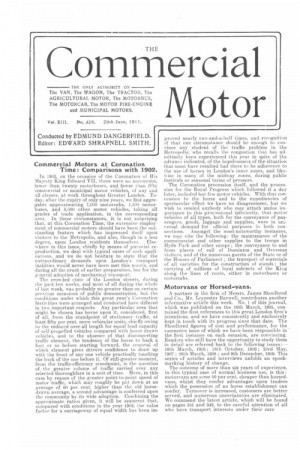Commercial Motors at Coronation Time Comparisons with 1902.
Page 1

If you've noticed an error in this article please click here to report it so we can fix it.
In 1902, on the occasion of the Coronation of His Majesty King Edward VII, there were no motorcabs, fewer than twenty motorbuses, and fewer than fifty commercial or municipal motor vehicles, of any and all classes, at work throughout Greater London. Today, after the expiry of only nine years, we find aggregates approximating 7,000 motorcabs, 1,500 motorbuses, and 5,000 other motor vehicles, taking all grades of trade application, in the corresponding area. In these circumstances, it is not surprising that, at this Coronation Time, the extensive employment of commercial motors should have been the outstanding feature which has impressed itself upon visitors to the Metropolis, and also, though in a less degree, upon London residents themselves. Elsewhere in this issue, chiefly by means of pictorial reproduction, we deal with typical cases of such applications, and we do not hesitate to state that the extraordinary demands upon London's transport facilities would never have been met this month, and during all the crush of earlier preparation, but for the general adoption of mechanical transport.
The crowded state of the London streets, during the past few weeks, and most of all during the whole of last week, was probably no greater than on certain previous occasions of public demonstration, but the conditions under which this great year's Coronation festivities were arranged and conducted have differed in two important respects. Any particular area that might be chosen has borne upon it, considered, first of all, from the standpoint of stationary traffic, at least fifty per cent, more vehicular units, chiefly owing to the reduced over-all length for equal load capacity of self-propelled vehicles compared with horse .drawn vehicles, and to the absence of that disconcerting traffic element, the tendency of the horse to back a foot or so before starting forward, the removal of which element gives drivers confidence to draw up with the front of any one vehicle practically touching the back of the one before it Of still-greater moment, from the traffic-efficiency standpoint, is the question of the greater volume of traffic carried over any selected thoroughfare in a unit of time. Here, in this case by reason of the greater point-to-point speed of motor traffic, which may roughly be pet down at an average of 60 per cent, higher than the old horsedrawn average, a second advantage is conferred upon the community by its wide adoption. Combining the approximate ratios given, it will be apparent that, compared with conditions in the year 1902, the value factor for a carriageway of equal width has been im proved nearly two-and-a-half times, and recognition of that one circumstance should be enough to convince any student of the traffic problem in the Metropolis, who recalls the congestion that has admittedly been experienced this year in spite of the advance indicated, of the hopelessness of the situation that must have resulted had there to be adherence to the use of horses in London's inner zones, and likewise in many of the midway zones, during public festivals or seasonal terms of pressure.
The Coronation procession itself, and the procession for the Royal Progress which followed it a day later, included but few motor vehicles. With that concession to the horse and to the expediencies of spectacular effect we have no disagreement, but we wish to remind anybody who may attach undue importance to this processional inferiority, that motor vehicles of all types, both for the conveyance of passengers, goods, luggage and supplies, were in universal demand for official purposes in both connections. Amongst the most-noteworthy instances, we may cite the following: the maintenance of the commissariat and other supplies to the troops in Hyde Park and other camps ; the conveyance to and from places of call of Dominion and Overseas visitors, and of the numerous guests of the State or of the Houses of Parliament ; the transport of materials of all varieties for the construction of stands ; the carrying of millions of loyal subjects of the along the lines of route, either in motorbuses or motorcabs.
Motorvans or Horsed-vans.
A partner in the firm of Messrs. James Shoolbred and Co., Mr. Leyeester Barwell, contributes another informative article this week. No. 1 of this journal, which was published on the 16th March, 1905, contained the first references to this great London firm's intentions, and we have consistently and exclusively kept in touch with its progress since that date. The Shoolbred figures of cost and performance, for the successive issue of which we have been responsible in the first instance on each occasion, are convincing. Readers who still have the opportunity to study them in detail are referred back to the following issues :— 16th March, 1905; 18th October, 1906: 23rd May, 1907 ; 26th March, 1908 ; and 9th I5ecember, 1909. This series of articles and interviews unfolds an epochmarking history of change. The outcome of more than six years of experience, in this typical case of normal business use, is this : motorvans are s.erne 50 per cent, cheaper than horsedvans, whilst they confer advantages upon traders which the possession of no horse establishment can confer. Turnover is increased, customers are better served, and numerous uncertainties are eliminated. We commend the latest article, which will be found on pages 341 and 342, to the careful attention of all who have transport interests under their care






































